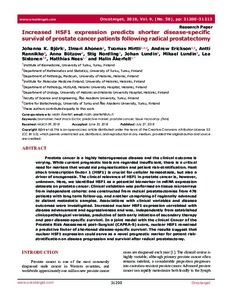Increased HSF1 expression predicts shorter disease-specific survival of prostate cancer patients following radical prostatectomy
Johanna K. Björk; Ilmari Ahonen; Tuomas Mirtti; Andrew Erickson; Antti Rannikko; Anna Bützow; Stig Nordling; Johan Lundin; Mikael Lundin; Lea Sistonen; Matthias Nees; Malin Åkerfelt
https://urn.fi/URN:NBN:fi-fe2021042719676
Tiivistelmä
Prostate cancer is a highly heterogeneous disease and the clinical
outcome is varying. While current prognostic tools are regarded
insufficient, there is a critical need for markers that would aid
prognostication and patient risk-stratification. Heat shock
transcription factor 1 (HSF1) is crucial for cellular homeostasis, but
also a driver of oncogenesis. The clinical relevance of HSF1 in prostate
cancer is, however, unknown. Here, we identified HSF1 as a potential
biomarker in mRNA expression datasets on prostate cancer. Clinical
validation was performed on tissue microarrays from independent cohorts:
one constructed from radical prostatectomies from 478 patients with
long term follow-up, and another comprising of regionally advanced to
distant metastatic samples. Associations with clinical variables and
disease outcomes were investigated. Increased nuclear HSF1 expression
correlated with disease advancement and aggressiveness and was,
independently from established clinicopathological variables, predictive
of both early initiation of secondary therapy and poor disease-specific
survival. In a joint model with the clinical Cancer of the Prostate
Risk Assessment post-Surgical (CAPRA-S) score, nuclear HSF1 remained a
predictive factor of shortened disease-specific survival. The results
suggest that nuclear HSF1 expression could serve as a novel prognostic
marker for patient risk-stratification on disease progression and
survival after radical prostatectomy.
Kokoelmat
- Rinnakkaistallenteet [27094]
